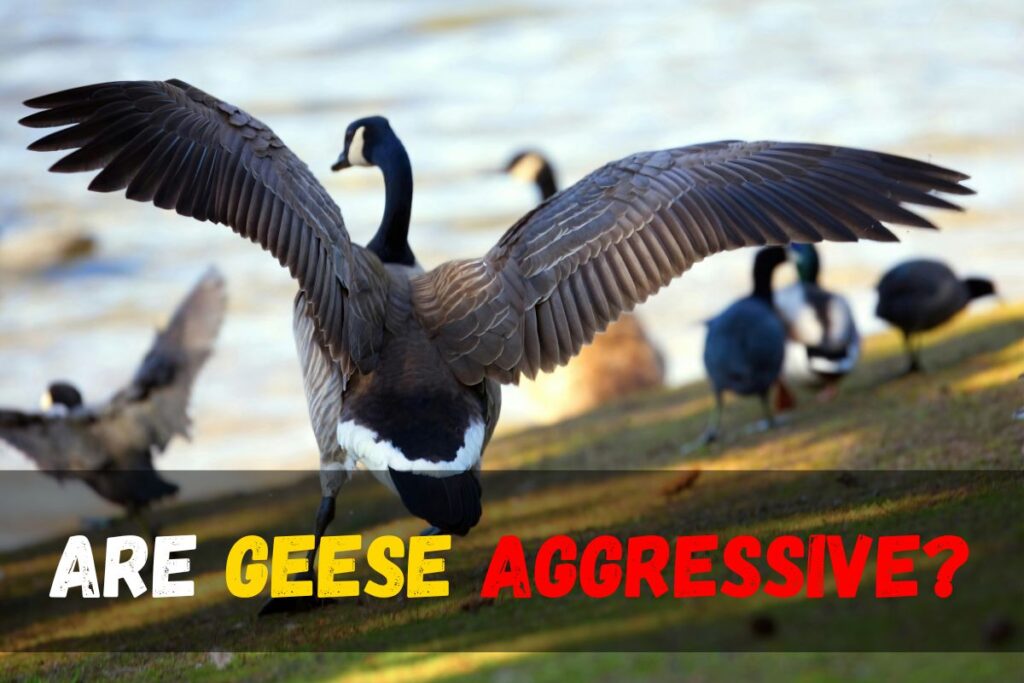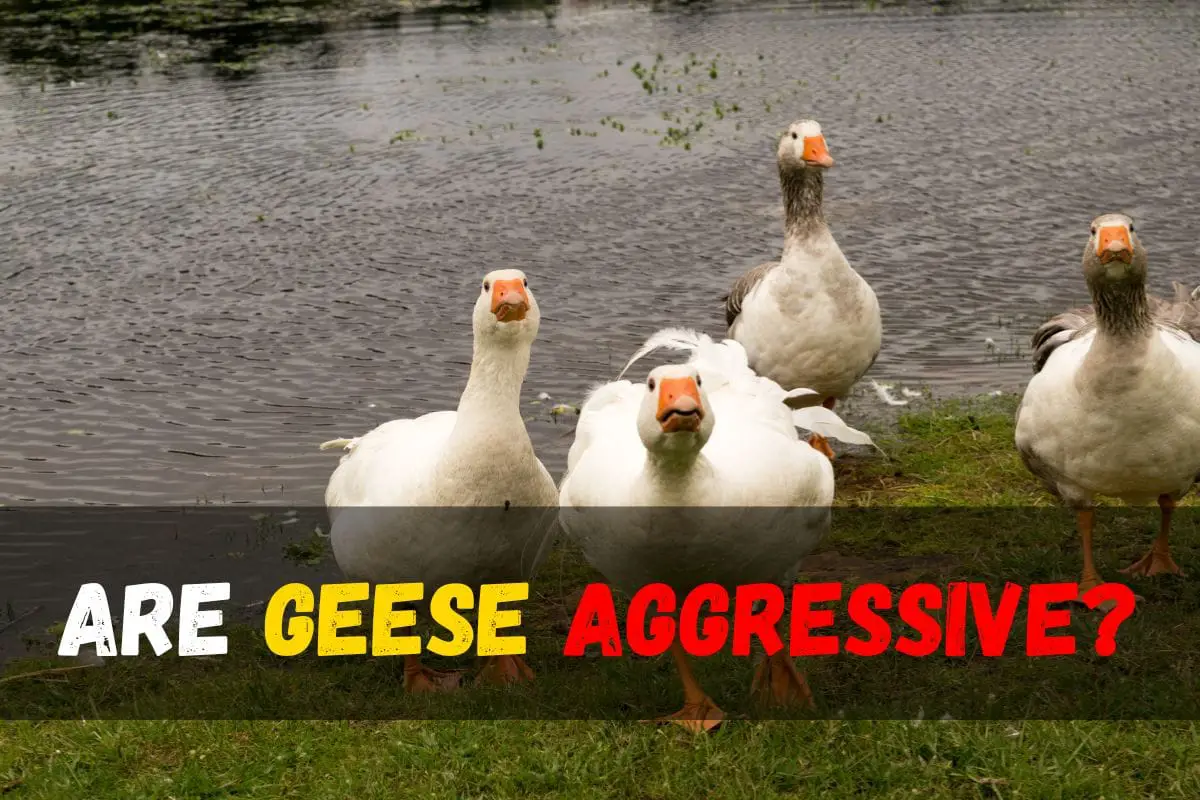Are geese aggressive?
Yes, geese can be aggressive, especially when they feel threatened or are protecting their territory, mates, or nests. Their aggression is most commonly seen during the breeding season when they are highly protective of their eggs and goslings. Geese may hiss, flap their wings, or charge at perceived threats, including humans and other animals.

Can Geese and Ducks Mate?
Despite their aggressive behaviour, geese usually prefer to scare off intruders rather than cause harm. Their displays are often more about intimidation, but they are capable of delivering painful bites and using their wings to strike.
Why are geese so aggressive or Attack Each Other?
Geese are often perceived as aggressive due to a combination of natural instincts and behaviours that have evolved for their survival. Here are the key reasons behind their aggression:
Do Geese Fly at Night?
- Territorial Nature: Geese are highly territorial, especially during the breeding season. They fiercely defend their nesting areas and offspring from perceived threats, including humans, animals, and other birds. This behaviour ensures the protection of their young and their territory, as geese prefer to nest in safe environments.
- Protective Instincts: Geese, especially parents, exhibit strong protective instincts. When they sense a threat near their nest or goslings, they will become aggressive to scare off predators. This defence mechanism is a crucial survival strategy for their young, who are vulnerable to many dangers in the wild.
- Hierarchy and Dominance: In a flock, geese establish a social hierarchy, and aggressive behaviours help maintain this structure. Dominant geese may show aggression toward others to assert their leadership, whether it’s over food, space, or mating rights.
- Fear and Perceived Threats: Geese are prey animals, so they are naturally cautious and wary of their surroundings. Aggression can often be a response to fear. If a goose feels cornered, threatened, or approached too closely, it may react aggressively to protect itself.
- Mating Season: During mating season, male geese (ganders) become more aggressive as they compete for mates and defend their chosen partner. Their increased aggression during this time can seem more intense as they’re driven by strong reproductive instincts.
Signs of Aggression in Geese
Geese, known for their territorial nature, can display various signs of aggression, especially when protecting their young or defending their habitat. Understanding these behaviours is essential for anyone working with or near geese, whether in farms, parks, or wildlife areas. Recognizing the early signs can help avoid conflicts and ensure safety.
What a Group of Geese is Called?
Hissing
One of the most noticeable signs of aggression in geese is hissing. This vocal warning indicates that the goose feels threatened and is ready to defend its territory. Hissing is often accompanied by other behaviours, such as wing flapping or head movements.
Raised Wings
Geese will raise their wings to make themselves appear larger when they feel threatened. This display is both a defensive and aggressive signal, warning intruders to stay away. The wings are spread wide, sometimes accompanied by loud honking or hissing to reinforce the threat.
When Do Geese Mate?
Head Low and Forward
An aggressive goose will often lower its head while pointing it forward, a clear sign of readiness to charge or attack. This posture indicates that the goose is preparing to defend its space or offspring, and anyone nearby should retreat to avoid provoking further aggression.
Why Do Geese Hiss?
Charging or Running Towards Intruders
Geese are known to charge at perceived threats. This aggressive behaviour, often accompanied by hissing and flapping, is meant to drive away potential intruders. While it may not always lead to physical contact, the charge itself is an intimidating tactic.
Biting or Pecking
When geese feel particularly threatened or cornered, they may resort to biting or pecking. Their beaks are strong enough to cause discomfort or minor injury, making this behaviour a more direct form of aggression.
Vocalizations (Honking)
In addition to hissing, geese will often honk loudly when displaying aggression. This honking serves as a warning to others, signalling that the goose is agitated and ready to defend itself or its territory.
Why Geese Honk When They Fly
Aggressive Posture (Body Upright)
Geese may also adopt an upright posture, puffing out their chests and holding their heads high. This stance is intended to signal dominance and control, often as a precursor to more overt signs of aggression, such as charging or biting.
Eye Contact
Aggressive geese will often maintain direct eye contact with their target, a clear sign that they are on alert and ready to act. Maintaining prolonged eye contact should be taken as a serious warning sign to back away.
Protective Behavior Around Nests
During nesting season, geese can become particularly aggressive. If a goose perceives a threat to its nest, it will become more protective and may display heightened aggression even from a distance. Approaching a nesting goose is particularly risky, as they will often escalate their defensive behaviour quickly.
How to Handle an Aggressive Goose
- Stay calm and composed, maintaining control over your emotions. Geese are more likely to attack if they sense fear or panic, so keeping your movements steady helps prevent escalation.
- Never run or make sudden movements, even if the goose charges. Running can encourage the goose to chase you, as they see it as a sign of weakness or fear.
- Maintain eye contact with the goose, showing confidence without being aggressive. Geese view eye contact as dominance, which can help you assert control over the situation.
- Slowly back away while facing the goose, using a calm pace. This prevents the goose from feeling more threatened and allows you to increase distance without triggering further aggression.
- Raise your arms or an object like a bag or coat to make yourself look larger. Geese are less likely to attack something that appears bigger and more imposing, helping to discourage aggressive behaviour.
- Avoid turning your back completely to the goose, as it may provoke further attacks. Keeping your body facing the goose helps you monitor its movements and anticipate any signs of aggression.
- Be mindful of goose nesting areas, especially during breeding season. Geese are most protective of their nests and will become highly aggressive if you come too close.
- If necessary, use an object like a stick or umbrella as a distraction. Wave it calmly to divert the goose’s attention while you continue to slowly retreat without making sudden movements.
- Keep children and pets away from aggressive geese, as they can be more vulnerable. Geese may see smaller individuals as easier targets and attack them more readily if they feel threatened.
- Do not feed geese or interact too closely, as this can make them more territorial. Geese that are regularly fed by humans can develop more aggressive behaviours, especially when expecting food.
Are geese dangerous?
Geese can be considered dangerous in certain situations, particularly when they feel threatened or are protecting their territory. They are known for their aggressive tendencies, especially during the breeding season, and may hiss, flap their wings, and charge at perceived threats, including humans. An aggressive goose can deliver painful bites and use its wings to strike, posing a risk of injury. Their territorial nature becomes more pronounced in areas where they have established nesting or feeding territories. When in groups, a single aggressive goose can incite others to join in, increasing the likelihood of confrontation. Overall, while geese can pose risks, most interactions can be managed with caution and respect for their space.
Do Geese Bite Humans
Yes, geese can bite humans, particularly when they feel threatened or are protecting their territory, nests, or goslings. Their bites can be painful and may lead to injuries, especially if the goose is aggressive or startled. While they typically display aggressive behavior through hissing, flapping wings, or charging, biting can occur as a form of defence. Most geese do not seek to attack humans unprovoked, but it’s essential to exercise caution around them, especially during the breeding season or near their nesting areas.
Are geese friendly to humans?
Geese can be friendly to humans, especially if they are accustomed to human presence and have had positive interactions in the past. Domestic geese, in particular, tend to be more sociable and may approach people for food or interaction. However, wild geese are generally more cautious and can be wary of humans, often maintaining a safe distance.
While many geese may show curiosity and tolerate human presence, it’s essential to remember that their behavior can change based on the context. During the breeding season or when protecting their nests and goslings, geese can become aggressive. Overall, while some geese can be friendly, it’s important to approach them with respect and caution, keeping their boundaries in mind.
Which geese are most aggressive?
- Canada Goose (Branta canadensis)
Canada geese are notorious for their territorial behavior and can be very aggressive, especially during nesting. They often hiss, flap their wings, and charge at perceived threats, making them a well-known aggressive species. - Egyptian Goose (Alopochen aegyptiaca)
Egyptian geese display aggressive behavior, particularly during the breeding season. They vigorously defend their nests and may chase away perceived threats to protect their young. - Greylag Goose (Anser anser)
Greylag geese are often aggressive when nesting and will protect their territory fiercely. Their assertive behavior includes hissing and charging at intruders who come too close. - Chinese Goose (Anser cygnoides)
Domestic Chinese geese can exhibit aggressive tendencies, especially when their territory is invaded. Their loud honking and protective behavior signal that they may not tolerate close proximity to perceived threats. - Toulouse Goose (Anser anser domesticus)
Toulouse geese can become aggressive when defending their nests or goslings. Their size and assertiveness make them formidable when they feel threatened or cornered. - Barnacle Goose (Branta leucopsis)
Barnacle geese can display aggressive behavior during nesting, particularly in densely populated areas. Competition for territory can trigger their defensive actions against intruders.


